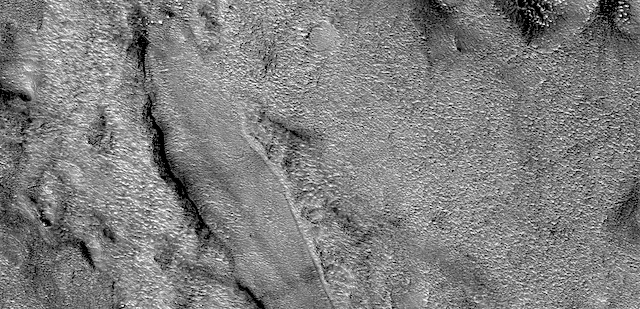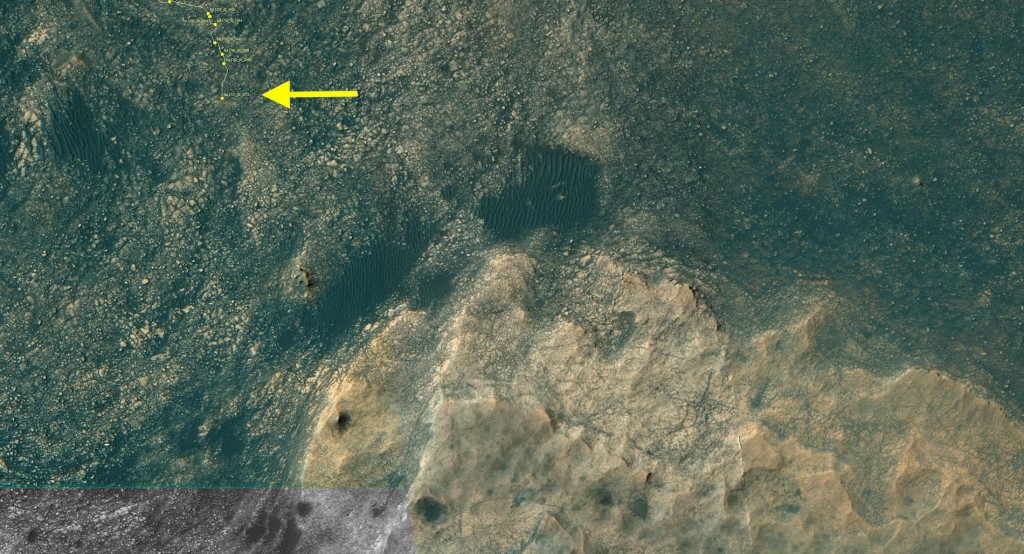-
Recent Posts
Archives
Links
general
mission instruments
- CRISM: Compact Reconnaissance Imaging Spectrometer for Mars
- CTX: Context Camera
- HiRISE: High Resolution Imaging Science Experiment
- MARSIS: Mars Advanced Radar for Subsurface and Ionosphere Sounding
- SHARAD: Shallow Radar
- THEMIS: Thermal Emission Imaging System
missions
- All Mars missions list
- Curiosity rover
- ExoMars
- Hope (al-Amal) orbiter
- InSight
- Mars Atmosphere and Volatile Evolution Mission (MAVEN)
- Mars Exploration Rovers (MER)
- Mars Express (MEX)
- Mars Odyssey
- Mars Orbiter Mission (MOM) / Mangalyaan
- Mars Reconnaissance Orbiter (MRO)
- Mars Science Laboratory (MSL)
- Perseverance Rover
- Tianwen-1 orbiter/rover
news
HiRISE: Channel near Hale Crater
Posted in Reports
Tagged Beautiful Mars, channels, Hale Crater, High Resolution Imaging Science Experiment, HiRISE, Mars Reconnaissance Orbiter, MRO, NASA, University of Arizona
Comments Off
Curiosity update: Wait and hurry up!
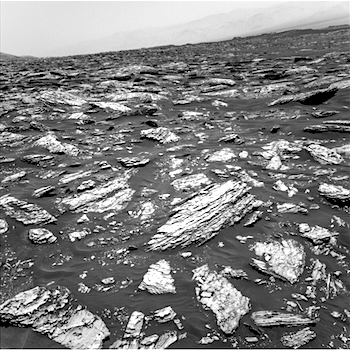 Sol 1719, June 6, 2017, update by MSL scientist Ryan Anderson: Today was an interesting day of planning: because of an issue with the computer system responsible for processing data once it is received on Earth, Curiosity’s images and other data from Sol 1718 didn’t arrive until well into today’s planning. That meant that we had to keep the plan simple and respond rapidly once the data did arrive. It also meant that we had plenty of time to choose our favorite target names from the list!
Sol 1719, June 6, 2017, update by MSL scientist Ryan Anderson: Today was an interesting day of planning: because of an issue with the computer system responsible for processing data once it is received on Earth, Curiosity’s images and other data from Sol 1718 didn’t arrive until well into today’s planning. That meant that we had to keep the plan simple and respond rapidly once the data did arrive. It also meant that we had plenty of time to choose our favorite target names from the list!
Once the data started rolling in, we quickly chose a nice piece of bedrock in front of the rover for APXS and MAHLI to analyze and gave it the target name “Aunt Betsey’s Brook”. We also planned a ChemCam observation of a flaky layered rock called “Wonsqueak Harbor” and a small Mastcam mosaic of a block of layered bedrock called “Little Round Pond”. After that, Curiosity will drive about 16 meters and collect… [More at link]
Posted in Reports
Tagged Aeolis Mons, Aunt Betsey's Brook, Curiosity, Gale Crater, Little Round Pond, Mars Science Laboratory, Mount Sharp, MSL, Murray Formation, NASA, Vera Rubin Ridge, Wonsqueak Harbor
Comments Off
Opportunity report, Sol 4746, by A.J.S. Rayl, The Planetary Society
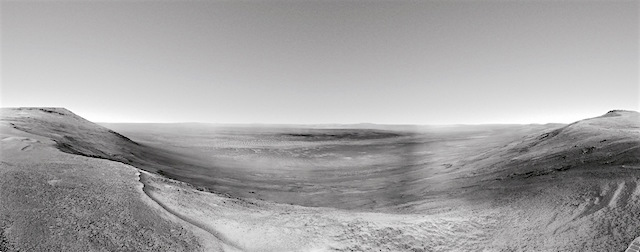 June 6, 2017: Opportunity shoots the moon on arrival at Perseverance Valley: In another dynamic demonstration of what can be achieved when a team works together, Opportunity cruised to the top of Perseverance Valley in May, shot the moon, and drove the Mars Exploration Rovers (MER) mission into its 160th month of surface operations.
June 6, 2017: Opportunity shoots the moon on arrival at Perseverance Valley: In another dynamic demonstration of what can be achieved when a team works together, Opportunity cruised to the top of Perseverance Valley in May, shot the moon, and drove the Mars Exploration Rovers (MER) mission into its 160th month of surface operations.
Perseverance Valley is a place unlike any the MER mission has visited and the rover’s arrival there represents a magnificent achievement. “We’ve proved through lots of perseverance that we could make it and we have arrived,” announced MER Principal Investigator Steve Squyres, the James A. Weeks Professor of Physical Sciences at Cornell University. “It’s so new and so different. And it’s really, really cool.”
Cutting west to east and forming a broad notch in Endeavour Crater’s western rim at Cape Byron, “the valley stretches downhill for the length of about two football fields, around 720 feet or 220 meters, top to bottom, on a slope of about 15 to 17 degrees,” said Deputy Principal Investigator Ray Arvidson, Washington University St. Louis… [More at link]
Posted in Reports
Tagged Cape Byron, Cape Tribulation, Endeavour Crater, Mars Exploration Rover, MER, NASA, Opportunity, Perseverance Valley
Comments Off
Curiosity: Mastcam scouting

 Sol 1717, June 5, 2017. After a 26-meter (86-foot) drive southward, the 34mm Mastcam shot a composite (7 MB) looking ahead at the path toward Vera Rubin Ridge. At right, the Hazcam views the ground immediately in front of Curiosity. Below, the rover’s approach to the ridge. (Click any image to enlarge it.)
Sol 1717, June 5, 2017. After a 26-meter (86-foot) drive southward, the 34mm Mastcam shot a composite (7 MB) looking ahead at the path toward Vera Rubin Ridge. At right, the Hazcam views the ground immediately in front of Curiosity. Below, the rover’s approach to the ridge. (Click any image to enlarge it.)
Sol 1717 raw images (from all cameras), and Curiosity’s latest location.
Posted in Reports
Tagged Aeolis Mons, Curiosity, Gale Crater, Mars Science Laboratory, Mount Sharp, MSL, Murray Formation, NASA, Vera Rubin Ridge
Comments Off
HiRISE: On a field of sublimation
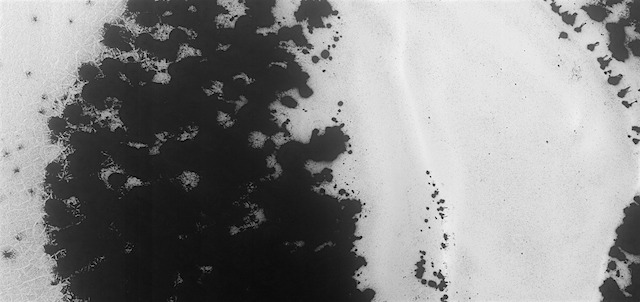 On a field of sublimation – Sublimation is a process where a solid directly turns into a gaseous state.
On a field of sublimation – Sublimation is a process where a solid directly turns into a gaseous state.
Beautiful Mars series.
Posted in Reports
Tagged Beautiful Mars, High Resolution Imaging Science Experiment, HiRISE, ice, Mars Reconnaissance Orbiter, MRO, NASA, south polar region, sublimation, University of Arizona
Comments Off
Collateral damage from cosmic rays increases cancer risk for Mars astronauts
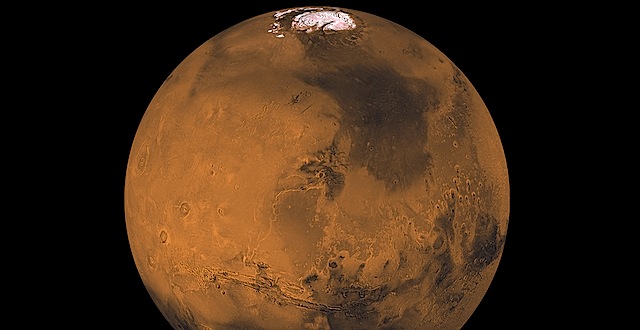 The cancer risk for a human mission to Mars has effectively doubled following a University of Nevada Las Vegas study predicting a dramatic increase in the disease for astronauts traveling to the red planet or on long-term missions outside the protection of Earth’s magnetic field.
The cancer risk for a human mission to Mars has effectively doubled following a University of Nevada Las Vegas study predicting a dramatic increase in the disease for astronauts traveling to the red planet or on long-term missions outside the protection of Earth’s magnetic field.
The findings appeared in the May issue of Scientific Reports and were presented by UNLV scientist Francis Cucinotta, a leading scholar on radiation and space physics.
Previous studies have shown the health risks from galactic cosmic ray exposure to astronauts include cancer, central nervous system effects, cataracts, circulatory diseases and acute radiation syndromes. Cosmic rays, such as iron and titanium atoms, heavily damage the cells they traverse because of their very high rates of ionization.
Conventional risk models used by NASA and others assume DNA damage and mutation are the cause of radiation cancers. This is based on studies at high doses where all cells are traversed by heavy ions one or more times within much shorter-time periods than will occur during space missions.
“Exploring Mars will require missions of 900 days or longer and includes more than one year in deep space where exposures to all energies of galactic cosmic ray heavy ions are unavoidable,” Cucinotta explained. “Current levels of radiation shielding would, at best, modestly decrease the exposure risks.”
In these new findings, a non-targeted effect model — where cancer risk arises in bystander cells close to heavily damaged cells — is shown to lead to a two-fold or more increase in cancer risk compared to the conventional risk model for a Mars mission. [More at links]
Posted in Reports
Tagged cancer, cosmic rays, galactic cosmic rays, human exploration, human spaceflight, solar coronal mass ejections, solar cosmic rays, solar energetic particles, solar flares
Comments Off
Curiosity update: Looking east
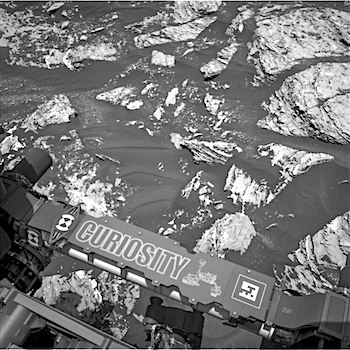 Sol 1718, June 5, 2017, update by MSL scientist Scott Guzewich: We are beginning to turn toward the east and southeast as we approach Vera Rubin Ridge with the Curiosity rover. After a busy and successful plan over the weekend, we weighed our priorities between using APXS to study the bedrock we’re driving over or drive farther along our path.
Sol 1718, June 5, 2017, update by MSL scientist Scott Guzewich: We are beginning to turn toward the east and southeast as we approach Vera Rubin Ridge with the Curiosity rover. After a busy and successful plan over the weekend, we weighed our priorities between using APXS to study the bedrock we’re driving over or drive farther along our path.
Today I was the Science Operations Working Group Chair as we planned sol 1718 and since we had only gained ~3m of elevation in our last drive, we decided to forgo contact science with APXS in favor of extending our drive distance. The GEO science theme group still found some interesting bedrock-”East Point” (the dark section in the middle of the rock at the upper right corner of the image), “East Pond”, and… [More at link]
Posted in Reports
Tagged Aeolis Mons, Curiosity, East Point, East Pond, Eastern Point Harbor, Gale Crater, Mars Science Laboratory, Mount Sharp, MSL, Murray Formation, NASA, Vera Rubin Ridge
Comments Off
THEMIS: Triple strike on Solis Planum
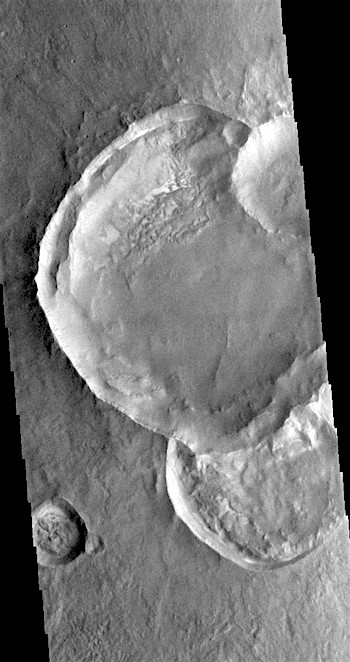 THEMIS image of the Day, June 6, 2017. Today’s VIS image is of a group of craters in Solis Planum. Because three of the craters are overlapping it is possible to determine the order in which those three were created.
THEMIS image of the Day, June 6, 2017. Today’s VIS image is of a group of craters in Solis Planum. Because three of the craters are overlapping it is possible to determine the order in which those three were created.
While we can not say exactly when in Martian history these craters formed, we can delineate the relative order of formation. Since impacts create circular craters, a recently formed crater will create a crescent into the crater it impacts.
So the order of impact in this image is 1) the crater at the bottom, 2) the large crater in the middle of the image, and 3) the small crater mostly off this image to the right.
More THEMIS Images of the Day by geological topic.
Posted in Reports
Tagged Arizona State University, ASU, craters, Mars Odyssey, multiple impacts, NASA, Solis Planum, THEMIS, THEMIS Image of the Day, Thermal Emission Imaging System, triplet craters
Comments Off
Curiosity update: If it’s worth doing, it’s worth doing right
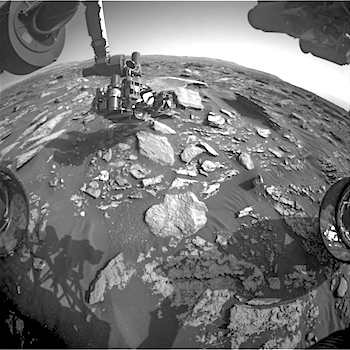 Sol 1715-17, June 5, 2017, update by MSL scientist Michelle Minitti: Curiosity left no stone unturned, unshot or unbrushed as she wrapped up observations at the stand of gray-toned rocks she arrived at on Sol 1712. We added to yesterday’s rich observations of gray-toned rocks by brushing a nodule-rich target, “Timber Point,” to give MAHLI and APXS as clear a look as possible of the target’s texture and chemistry. We added to yesterday’s rich observations of gray-toned rocks by brushing a nodule-rich target, “Timber Point,” to give MAHLI and APXS as clear a look as possible of the target’s texture and chemistry. Scattered amongst the gray-toned rocks were patches of Murray formation rocks, and the team thought it best not to neglect our old friend. MAHLI images and APXS data from the Murray target “Old Mill Brook” will… [More at link]
Sol 1715-17, June 5, 2017, update by MSL scientist Michelle Minitti: Curiosity left no stone unturned, unshot or unbrushed as she wrapped up observations at the stand of gray-toned rocks she arrived at on Sol 1712. We added to yesterday’s rich observations of gray-toned rocks by brushing a nodule-rich target, “Timber Point,” to give MAHLI and APXS as clear a look as possible of the target’s texture and chemistry. We added to yesterday’s rich observations of gray-toned rocks by brushing a nodule-rich target, “Timber Point,” to give MAHLI and APXS as clear a look as possible of the target’s texture and chemistry. Scattered amongst the gray-toned rocks were patches of Murray formation rocks, and the team thought it best not to neglect our old friend. MAHLI images and APXS data from the Murray target “Old Mill Brook” will… [More at link]
Posted in Reports
Tagged Goose Eye Mountain, Old Mill Brook, Spectacle Island, Timber Point
Comments Off









